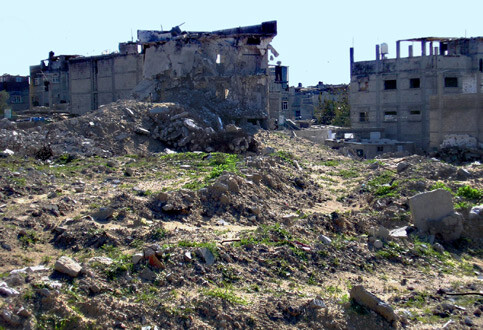UN Office for the Coordination of Humanitarian Affairs 12 September 2005

At the edge of the Khan Yunus refugee camp in the southern Gaza Strip, crumbling refugee homes face off with the red-roofed seafront villas of the Neve Dekalim settlement. (Arjan El Fassed)
The Israeli Defence Forces (IDF) completed their withdrawal from Gaza at 7 am this morning. Operation Last Watch ended with a brief ceremony at Qissufim road crossing when the national flag was re-raised by Gaza Division troops on the Israeli side of the crossing.
Palestinian National Security Forces progressively moved into the former settlements throughout Sunday night and into the early hours of this morning. In spite of their presence, synagogues were set ablaze in Netzarim, Kfar Darom and Morag by groups of Palestinians who followed behind the security forces.
Status of former settlements
All former settler homes were dismantled by the IDF prior to their departure. Only a small number of municipal and commercial buildings now remain and the PA will decide their future.
The settlements are now under the control of Palestinian security forces, although tens of thousands of Palestinians have subsequently entered including armed militants in Kfar Darom.
Official celebrations organised by the PA are expected to take place in Al Mawasi and Neve Dekalim later this week.
Following a cabinet meeting on Sunday, the Israeli government decided that it could not demolish 27 synagogues and has left the responsibility to the PA, in spite of its reluctance to take such on such action.
The rubble from the former settler homes will be transferred to the Sinai under the auspices of the United Nations Development Programme (UNDP).
The PA will conduct evaluations of the former settlements in order to check for unexploded ordanance and hazardous materials while also assessing the remaining infrastructure.
External movements
Erez crossing has remained open throughout the disengagement with limited numbers of merchants and workers crossing on a daily basis to Israel. Today 174 workers and 159 merchants were able to leave Gaza.
Rafah terminal closed on 7 September for movement in both directions and is unlikely to re-open for up to six months. The terminal remains intact but the Joint Verification Team (JVT) building was demolished at the weekend by the IDF.
Karni terminal and Nahal Oz crossing have remained open throughout the disengagement except for 22 August when Netzarim was evacuated.
Internal movements and closure
Abu Houli junction now has free movement of traffic in both directions following the dismantling of the IDF observation posts to the north and south of the junction and the withdrawal of Israeli forces. Abu Houli junction bridge that linked Gush Katif with the Qissufim road was demolished towards the end of last week.
Salah ed Din street – Netzarim junction will reopen once engineers have been able to conduct repairs. The junction to the east of Netzarim settlement opened following the July 2003 hudna but closed again shortly afterwards.
Rafah-west Khan Younis road will similarly reopen following repairs by Municipal engineers. This road has been closed since October 2000.
The former enclaves of Al Mawasi, Al Maáni and As Siafa are now accessible following the dismantlement of checkpoints at Tuffah and Tel es Sultan (Al Mawasi) and the fences that had previously surrounded the populations.
Humanitarian issues
There is a need for the Palestinian security forces to take control of the former settlement areas to ensure people’s safety. Already three people have drowned today in the seas off Al Mawasi and seven people have been injured when falling from buildings in the former Gush Katif block.
Hazardous waste and unexploded ordanance. Under the terms of the withdrawal the Israeli government had an obligation to ensure that all hazardous materials were removed from the homes of settlers before being demolished. There is a need for technical experts to verify the situation in relation to hazardous and unexploded materials at the earliest opportunity.
The continuing closure of Rafah passenger terminal and the inability of the Israelis and PA to agree over movement through Kerem Shalom will directly impact on the 600 to 700 Palestinians who leave Gaza each month to receive secondary health treatment. Many of these patients receive treatment for cancer conditions and are not able to wait for medical provision on a long term basis when alternative treatment is not available locally.
Enclaves. Residents living in Al Mawasi and As Siafa have effectively been cut off from Gaza for the last five years. There is a need for these residents to be reintegrated back into their host communities at the earliest opportunity. The Ministry of Planning’s Gaza Regional Plan may serve as a useful means for achieving this aim.
Coordination
The Gaza Security/Operations room centred in the UNRWA radio room has been operational since Monday, 15 August and provides an information hotline – 08 284 7719, SMS service and blog facility.
Coordination meetings continue in Gaza city in the health, water/sanitation, education and psychosocial/child protection sectors.
OCHA is acting as a focal point with the (acting) Association of International Development Agencies (AIDA) Facilitator to enable coordination and information exchange with the NGOs.
There is regular contact between the Operations room and the Israeli DCL to discuss issues of common concern.
Related Links